Chemical agents are toxic compounds that may be determined to be present in munitions and certain materials of interest. Blister agents (e.g., mustard, lewisite) are the chemical agents most likely to be encountered. Chemical weapons include several types of munitions (e.g., rockets, land mines, projectiles, bombs) that may contain different chemical agent (e.g., mustard, phosgene). (See Figure 1)
Figure 1: Common Chemical Agents†
| Name | Military Code | Chemical Abstract Service Registry Number | Action | State | Agency for Toxic Substances & Disease Registry (ATSDR) Link |
| Blister Agents | |||||
Lewisite |
L | 541-25-3 |
Rapid | Liquid | ToxFAQs™ for Blister Agents: Lewisite (L), Mustard-Lewisite Mixture (HL). |
Mustard Lewisite |
HL | – | Delayed | Liquid | |
Sulfur mustard |
H/HD |
505-60-2 |
Delayed | Liquid | ToxFAQs™ for Blister Agents: Sulfur Mustard Agent H/HD, Sulfur Mustard Agent HT |
Mustard-T mixture |
HT | – | Delayed | Liquid | |
Nitrogen Mustards |
HN-1 HN-2HN-3 |
538-07-8 51-75-2555-77-1 |
Delayed | Liquid | ToxFAQs™ for Blister Agents: HN-1, HN-2, HN-3 (Nitrogen Mustards) |
| Blood Agents | |||||
Cyanogen Chloride |
CK | 506-77-4 |
Rapid | Gas | |
Hydrogen Cyanide |
AC | 74-90-8 |
Rapid | Gas | |
| Choking Agents | |||||
Phosgene |
CG | 75-44-5 |
Delayed | Gas | |
| Nerve Agents | |||||
| Sarin | GB | 107-44-8 |
Very Rapid | Liquid | |
| Tabun | GA | 77-81-6 |
Very Rapid | Liquid | |
0-Ethyl S-2-diisopropylaminoethyl methyl phosphonothiolate |
VX | 50782-69-9 |
Rapid | Liquid |
† This is not a list of all chemical agents or a list of all chemicals subject to the Chemical Weapons Convention (CWC). |
The United States ceased open-air testing of lethal, unitary chemical agents in 1969. Disposal of chemical warfare materiel (CWM) (i.e., chemical munitions and bulk containers of chemical agents) by burial is believed to have also ended at that time. In 1970, DoD ceased sea disposal of CWM. (The RCWM Program does not address sea-disposed CWM, unless such is recovered and poses an unacceptable risk to the public or critical assets)
RCWM found at burial sites and testing ranges dates back as far as 1915, when the U.S. Army began studying chemical warfare following the use of chlorine gas by the Imperial German Army at the start of the Second Battle of Ypres, Belgium. Training with chemical agent identification sets (CAIS) began shortly after World War I and most kits were likely consumed in training. The use of CAIS largely ceased in the early 1970s with remaining stores being recalled to Rocky Mountain Arsenal in the late 1970s for destruction. Additional information on Chemical Munitions is provided in the U.S. Chemical Weapons and Related Materiel Reference Guide .
Figure 2 lists examples of the types of CAIS that may be recovered as the military investigates munitions response sites.
Figure 3 lists examples of the types of CWM that may be recovered as the military investigates munitions response sites. Please note, the information in both tables should not be used to make identification of any unexploded ordnance (UXO), discarded military munitions (DMM), or CAIS encountered by the public.
Figure 2: Chemical Agent Identification Sets (CAIS) Typically Recovered at CWM Sites
| Name | Description | Fill |
Dimensions Total Weight Agent Weight |
Illustration |
| CAIS, Toxic Gas Set, M1 (K941) | This CAIS consists of 24 screw top, glass bottles, each containing 3½ ounces of pure mustard (H or HD); packed 4 to a metal can within a metal shipping tube. Used WWII through the 1950s, and obsoleted in 1971. | H HD |
Bottles are 5 x 2 inch (approx.) Total of 84 ounces of agent per kit. |
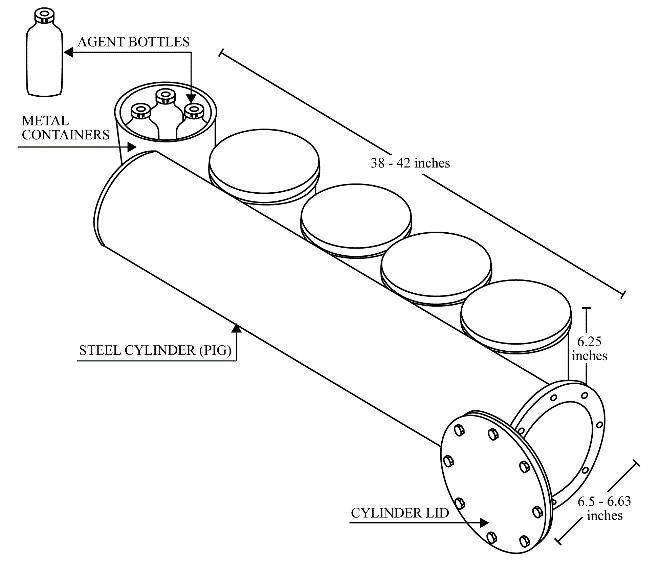 |
| CAIS, War Gas Identification Set, M1 (K951/K952) | This CAIS includes 48 1.4-ounce glass ampoules packed in cardboard tubes, with 12 tubes to a sealed can within a metal shipping tube. These CAIS were shipped as both instructional (K952) and detonating (K951). The detonating kits shipped with an accessory kit containing blasting caps, a reel of wire and a blasting machine. Used from the 1930s through the late 1950s, and obsoleted in 1971. | HD (5% in chloroform) L (5% in chloroform) PS (50% in chloroform) CG |
Ampules are 7.5 x 1 inch (approx.) Total fluid in the kit was about 67.2 ounces, of which, 26 ounces was agent per set. |
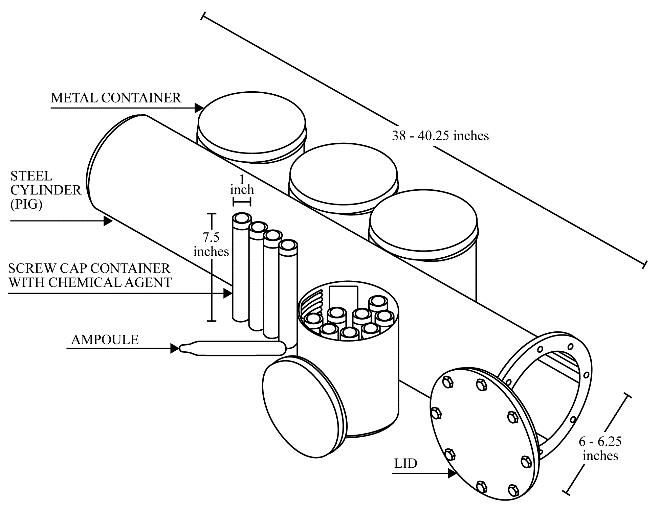 |
| CAIS, War Gas Identification Set, AN-M1A1 (K953/K954) | This CAIS includes 48 1.4-ounce glass ampoules packed in cardboard tubes, with 12 tubes to a sealed can within a metal shipping tube. The kit contained 8 tubes of each type. Used during the Korean Conflict Era, and obsoleted in 1971. | HD (5% in chloroform) HN-1 (10% in chloroform) L (5% in chloroform) CG CK GA-simulant |
Ampules are 7.5 x 1 inch (approx.) Total fluid in the kit was about 67.2 ounces, of which, 23.8 ounces was agent |
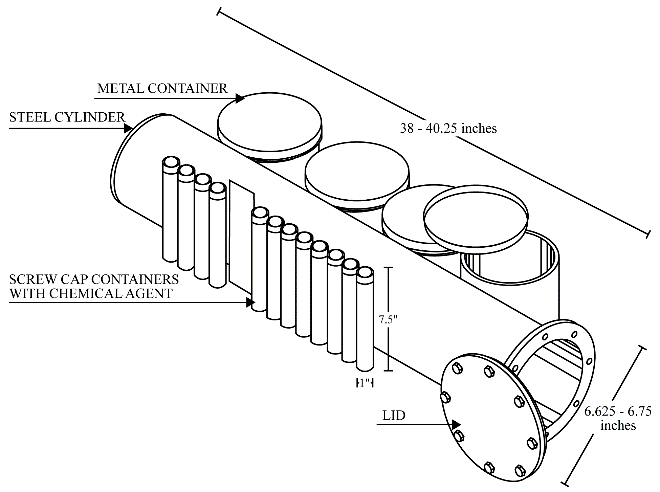 |
Figure 3: Examples of Recovered Chemical Warfare Materiel†
Name |
Description |
Fill |
Dimensions Total Weight Agent Weight |
Illustration |
|
Mortar, 8-inch, Livens Projectile, MK1, MK2, MK2A1 |
MK1 made from lap-welded steel.
MK2, MK2A1 made from seamless drawn steel pipe; varied in assembly. |
Blister Choking Explosive Incendiary Smoke |
22 x 8 inches
60-61.5 pounds (lbs) gross weight
28-30 lbs fill |
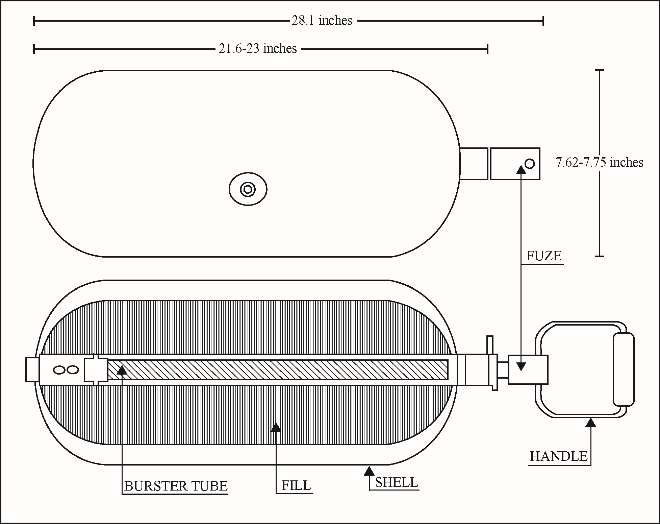
|
4-inch Stokes Mortar, MI |
MK1 lap-welded or hot-drawn steel body. Separate endplates wider than body sealed the ends. |
Blister Choking Explosive Incendiary Riot Control Smoke |
17.5-19.6 x 4.2 inch
24 lbs gross
6-9 lbs fill |
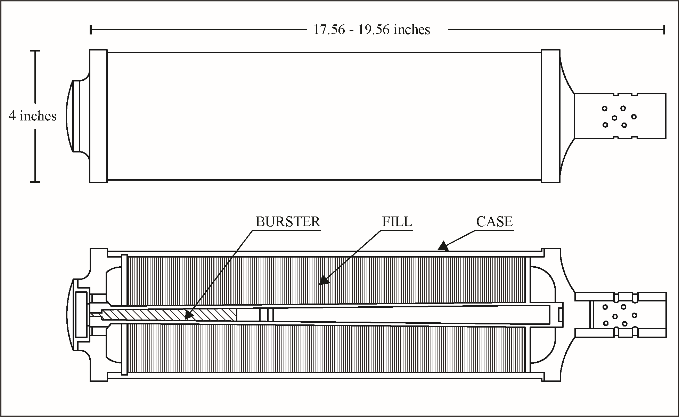 |
4.2-Inch Mortar, M1, M1A1, M2, M2A1 |
One-piece, forged-steel body, integral base and walls, casing swaged to form the ogive, a point detonating fuze with an integral burster, and a tail assembly. |
Blister Choking Explosive Incendiary Riot control Smoke |
21 x 4.2 inch
22-26 lbs gross
5-8 lbs fill |
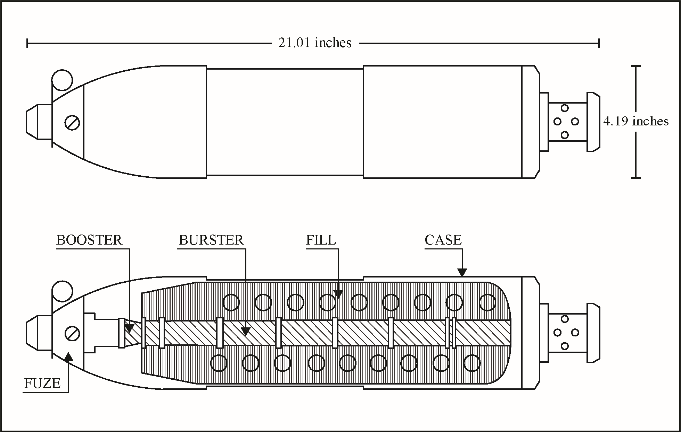
|
75 millimeters (mm) Projectile, MK2 |
Steel body containing the liquid; and an adapter and booster casing (gaine tube) screwed into the nose containing the bursting charge. |
Blister Choking Riot control Smoke |
11 x 3 inch
11-13 lbs gross
1-2 lbs fill |
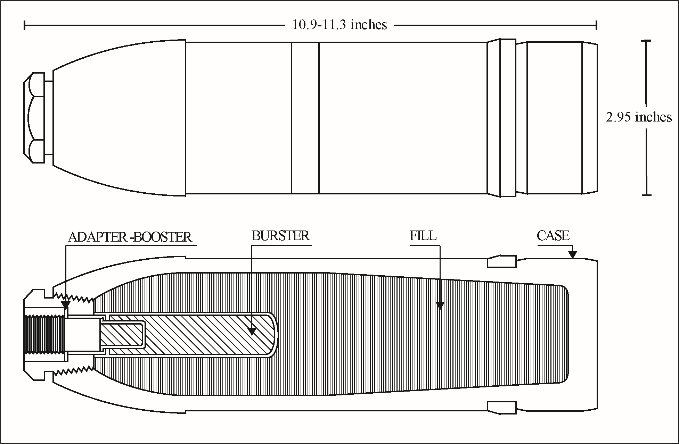
|
105mm Projectile, M60 (4E1) |
Forged steel body with threaded steel nose adapter for fill seal, boat-tail base, gilding metal rotating band, and streamlined ogive. |
Blister Smoke |
19 x 4 inches
32-43 lbs gross
2.7-4.6 lbs fill |
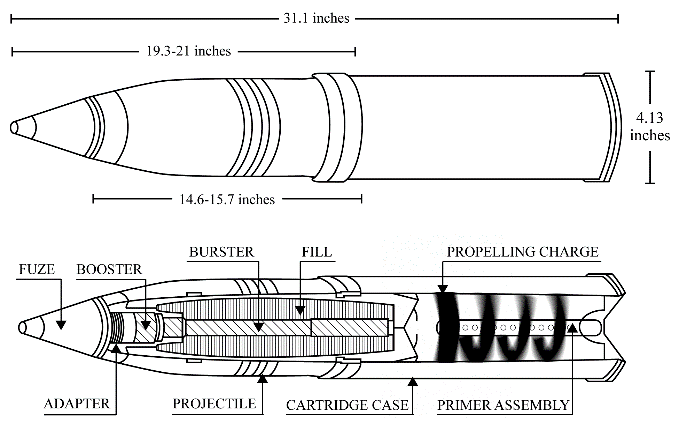
|
155mm Projectile, M104 |
Hollow steel body with threaded adapter for central burster tube, and rotating band near base. |
Blister Smoke |
27 x 6 inches
94-100 lbs
10-17 lbs |
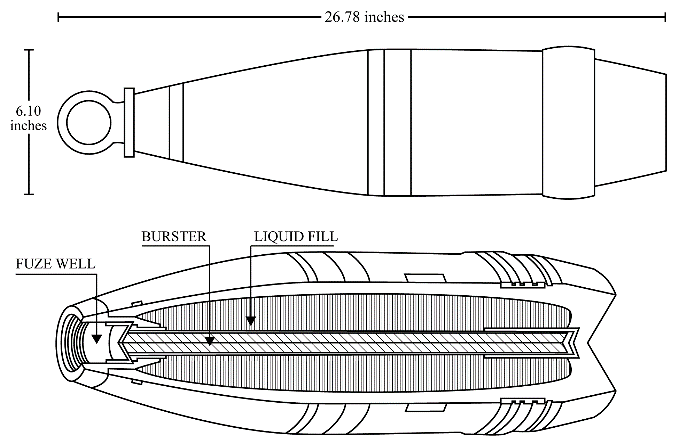
|
155mm Projectile, M110 |
Forged steel body with full-length burster, metal rotating band near the base; threaded nose for lifting plug or fuze. |
Blister Riot Control Smoke |
28 x 6 inches
92.5-99.4 lbs gross
9.7 lbs-16.9 lbs fill |
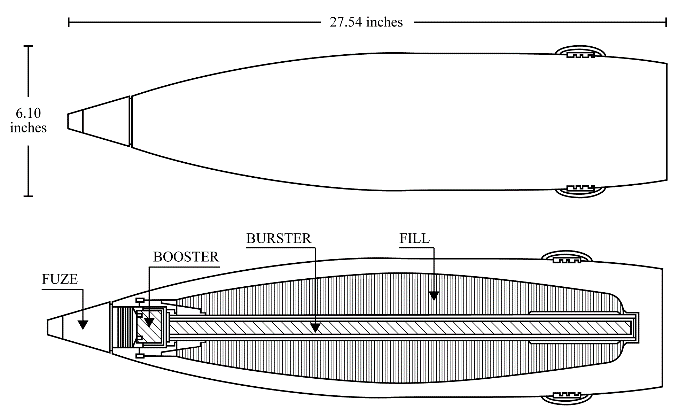
|
100-pound Bomb, M47, M47A1, M47A2, M47A4 |
Thin-skinned bomb with a burster well extending its length. The bomb was equipped with box fins. |
Blister Incendiary Smoke |
40 (body) x 8 inches
60-131 lbs gross
40-103 lbs fill |
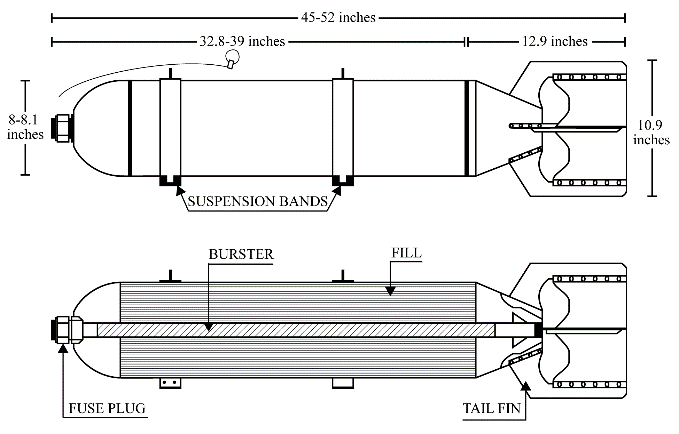
|
|
M70 Bomb |
Fin-stabilized, cylindrical bomb with ogive nose and conical tail. Equipped with press-fit burster well running axially the length of the bomb. |
Blister Smoke |
40 (body) x 8 inches
122-128 lbs
57-61 lbs |
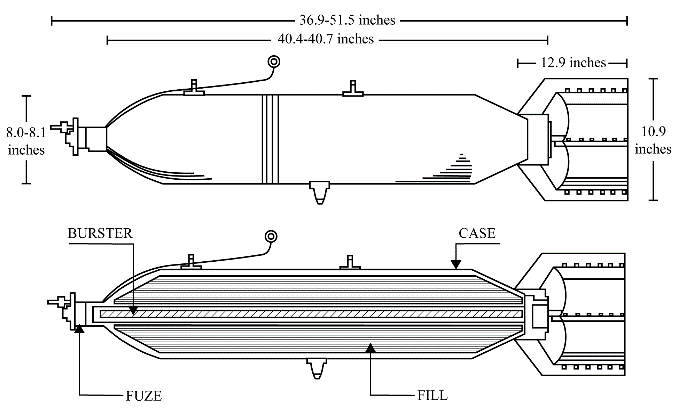
|
† The CWM shown in this table may be similar to unused CWM declared under the CWC and destroyed under the Chemical Stockpile Disposal Program; however, encounters at a CWM site require an item- and fact-specific evaluation to determine applicability of the CWC. |
